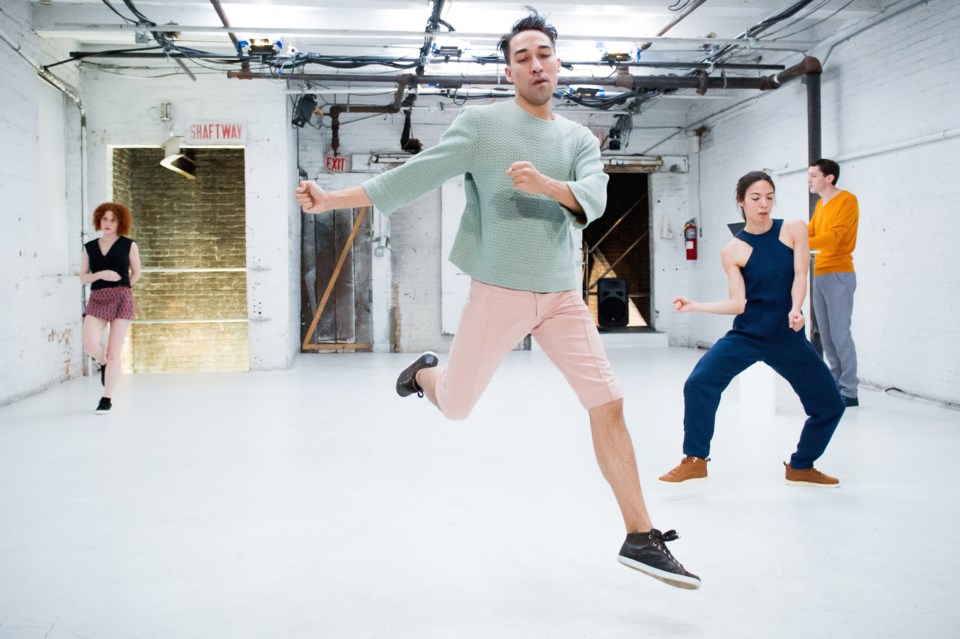Relative Collider is a performance steeped in science: the dance steps (the walks, skips, jumps and jetés) are studies in thermodynamics, gathering energy and colliding with the audience’s gaze.
The piece can also be considered a machine, with the performers’ bodies reduced to the binary of arms and legs, left foot and right foot, moving through a set of 64 repeating motions.
But, like any machine, the show won’t really do anything unless you turn it on.
“When we were beginning Relative Collider, or, rather, the research for it, [I wondered if it would] be possible for the audience to directly influence the piece, even if what we are doing is a sort of... a written machine,” says choreographer Liz Santoro, speaking by phone from Paris, where she lives when not working out of New York. “We had these ideas of creating a machine that gets turned on, like a power button – a switch that the audience creates – so that the piece is actually being created in real time.”
It’s an altogether complex idea – meant to explore what happens to the audience, and the performance, when we pay attention – informed largely by Santoro’s unconventional background.
In fact, the dancer, who trained at Boston Ballet School and has worked with choreographers such as Alexandra Bachzetsis, Jack Ferver, Philipp Gehmacher, David Wampach and Ann Liv Young, chose to deviate from her artistic endeavours to study neuroscience at Harvard, where she completed a bachelor’s degree in 2001.
She was ultimately drawn back to dance, but says her interest in science never waned.
“I have a fantasy to visit the particle collider in Switzerland,” she laughs. “It’s this sort of metaphor for Relative Colliderin the sense that when you put two objects in front of each other – an audience and the performers – […] and you send them at each other at extremely high speeds, when they collide you can sort of see what they’re made up of.”
But how does that translate here? Very precisely, as it turns out.
In the midst of explaining how it works, Santoro stops and decides it might just be easier to email over a dossier that breaks the 45 meticulous minutes of Relative Collider (taking place Feb. 4-6 at the Scotiabank Dance Centre as part of the ongoing PuSh International Performing Arts Festival) down.
The document reads like a graduate thesis statement but, amidst all the charts and diagrams, lies the theory that the piece – through every flexed wrist or lifted heel – offers the opportunity to see and experience an exchange of information, based on the physics of how we give and receive attention.
Santoro calls it the “collision of watching”.
It begins with the performers – Santoro, her partner and collaborator Pierre Godard, and dancers Cynthia Koppe and Stephen Thompson – filing into the pristine, laboratory-white space.
They are neatly and sportily dressed, as if they were out for a walk and decided to pop in for the show.
Godard silently takes his position behind a podium and activates a metronome track on his laptop.
Then, the three remaining dancers start to move, slowly at first, beginning with the feet.
Left, right, left, right.
Right, left, right, right...
As tension mounts, you notice the dancers’ arms are also switched on, moving in patterns based on choreography from Santoro’s Bessie-nominated 2012 piece, We Do Our Best.
Eventually, their motions become more dramatic, more determined, and the dancers prance and lunge and begin to fill the space around them, as if guided by an unseen rule.
“We wanted to sort of take the machine through its paces in the actual space that we’re in,” says Santoro, “so it’s a bit like pouring water into a container, where the water takes the form of the container it’s in.”
Just when the performers seem to have the footwork down, however – about halfway through the hypnotically contemplative piece – they are forced to switch, to perform the complete reverse of what they have been doing: lefts where there were rights, rights where there were lefts.
“It’s a bit of a... trick? I’m trying to think of a way to not say the word mind-fuck,” she laughs. “Because the arm sequence does not change at all, but the feet do. It’s this thing where […] we’re putting our nervous systems and our capacity [for performance] at risk.”
Meanwhile, in addition to the click of the metronome, Relative Collider unfolds to a live, randomly generated vocal score. The text comes from a program written by Godard (an engineer with his master of natural language processing) that searched through 50,000 books in Project Gutenburg’s digital library to find words and phrases that sync up with the desired beat.
Read aloud by Godard as they appear on his computer screen, the excerpts span everything from Shakespeare to the Koran, marking the final piece in this living, breathing brainteaser.
• Relative Collider runs Feb. 4-6 at the Scotiabank Dance Centre (677 Davie). Tickets $36; PuShFestival.ca


